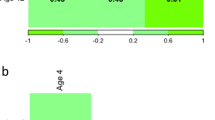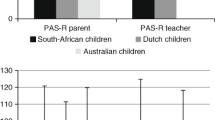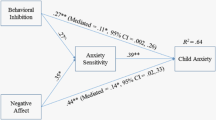Abstract
There has been limited research examining the additive and interactive effects of multiple factors on the development of anxiety symptoms and anxiety disorders in youths. This study was an attempt to examine the reciprocal connections among temperament, attachment, and rearing style, and their unique and interactive relations to anxiety symptoms. Six hundred forty-four non-clinical children aged 11–15 years (mean age = 12.7 years) completed questionnaires measuring behavioral inhibition, attachment, parental rearing behavior, and anxiety symptoms. Results indicated that there were small to moderate positive correlations among various risk factors. Furthermore, modest but significant positive correlations were found between behavioral inhibition, attachment quality, and anxious and controlling rearing behaviors on the one hand, and anxiety scores on the other hand. That is, higher levels of behavioral inhibition, insecure attachment, and parental control and anxious rearing were associated with higher levels of anxiety symptoms. Finally, behavioral inhibition, attachment quality, parental control and anxious rearing each accounted for a small but unique proportion of the variance of anxiety disorders symptomatology. Little support was found for interactive effects of these vulnerability factors on childhood anxiety.

Similar content being viewed by others
References
Armsden, G. C., & Greenberg, M. T. (1987). The inventory of parent and peer attachment: Individual differences and their relationship to psychological well-being in adolescence. Journal of youth and adolescence, 16, 427–454.
Barrett, P., Rapee, R., Dadds, M. R., & Ryan, S. M. (1996). Family enhancement of cognitive style in anxious and aggressive children: Threat bias and the FEAR effect. Journal of Abnormal Child Psychology, 24, 187–203.
Bernstein, G. A., Borchardt, C. M., & Perwien, A. R. (1996). Anxiety disorders in children and adolescents: A review of the past 10 years. Journal of the American Academy of Child and Adolescent Psychiatry, 35, 1110–1119.
Biederman, J., Rosenbaum, J. F., Bolduc-Murphy, E. A., & Faraone, S. V. (1993). A three year follow-up of children with and without behavioral inhibition. Journal of the American Academy of Child and Adolescent Psychiatry, 32, 814–821.
Biederman, J., Rosenbaum, J. F., Hirshfeld, D. R., Faraone, S. V., Bolduc, E. A., Gersten, M., Meminger, S. R., Kagan, J., Snidman, N., & Reznick, J. S. (1990). Psychiatric correlates of behavioral inhibition in young children of parents with and without psychiatric disorders. Archives of General Psychiatry, 47, 21–26.
Birmaher, B., Brent, D. A., Chiappetta, L., Bridge, J., Monga, S., & Baugher, M. (1999). Psychometric properties of the Screen for Child Anxiety Related Emotional Disorders (SCARED): A replication study. Journal of the American Academy of Child and Adolescent Psychiatry, 38, 1230–1236.
Birmaher, B., Khetarpal, S., Brent, D., Cully, M., Balach, L., Kaufman, J., et al. (1997). The Screen for Child Anxiety Related Emotional Disorders (SCARED): Scale construction and psychometric characteristics. Journal of the American Academy of Child and Adolescent Psychiatry, 36, 545–553.
Calkins, S., & Fox, N. (1992). The relations among infant temperament, security of attachment, and behavioral inhibition at twenty-four months. Child Development, 63, 1456–1472.
Castro, J., Toro, J., Van Der Ende, J., & Arrindell, W. A. (1993). Exploring the feasibility of assessing perceived parental rearing styles in Spanish children with the EMBU. International Journal of Social Psychiatry, 39, 47–57.
Costello, E. J., & Angold, A. (1995). Epidemiology. In J. S. March (Ed.), Anxiety disorders in children and adolescents (pp. 109–124). New York: Guilford Press.
Craske, M. G. (1997). Fear and anxiety in children and adolescents. Bulletin of the Menninger Clinic, 61(suppl. A), A4–A36.
Gest, S. D. (1997). Behavioral inhibition: Stability and associations with adaptation from childhood to early adulthood. Journal of Personality and Social Psychology, 72, 467–475.
Grüner, K., Muris, P., & Merckelbach, H. (1999). The relationship between anxious rearing behaviours and anxiety disorders symptomatology in normal children. Journal of Behavior Therapy and Experimental Psychiatry, 30, 27–35.
Hudson, J. L., & Rapee, R. M. (2001). Parent-child interactions and anxiety disorders: An observational study. Behaviour Research and Therapy, 39, 1411–1427.
Kagan, J., Reznick, J. S., & Snidman, N. (1988). Biological bases of childhood shyness. Science, 240, 167–171.
Mannasis, K., Bradley, S., Goldber, S., Hood, J., & Swinson, R. P. (1994). Attachment in mothers with anxiety disorders and their children. Journal of the American Academy of Child and Adolescent Psychiatry, 33, 1106–1113.
Mannasis, K., Bradley, S., Goldberg, S., Hood, J., & Swinson, R. P. (1995). Behavioural inhibition, attachment and anxiety in children of mothers with anxiety disorders. Canadian Journal of Psychiatry, 40, 87–92.
Muris, P. (2006). The pathogenesis of childhood anxiety disorders: Considerations from a developmental psychopathology perspective. International Journal of Behavioral Development, 30, 5–11.
Muris, P., Bosma, H., Meesters, C., & Schouten, E. (1998). Perceived parental rearing behaviours: A confirmatory factor analytic study of the Dutch EMBU for children. Personality and Individual Differences, 24, 439–442.
Muris, P., Mayer, B., & Meesters, C. (2000a). Self-reported attachment style, anxiety, and depression in children. Social Behavior and Personality, 28, 157–162.
Muris, P., & Meesters, C. (2002). Attachment, behavioral inhibition, and anxiety disorders symptoms in normal adolescents. Journal of Psychopathology and Behavioral Assessment, 24, 97–105.
Muris, P., Meesters, C., Merckelbach, H., & Hülsenbeck, P. (2000b). Worry in children is related to perceived parental rearing and attachment. Behavior Research and Therapy, 38, 487–497.
Muris, P., Meesters, C., & Spinder, M. (2003a). Relationships between child- and parent-reported behavioural inhibition and symptoms of anxiety and depression in normal adolescents. Personality and Individual Differences, 34, 759–771.
Muris, P., Meesters, C., & van Brakel, A. (2003b). Assessment of anxious Rearing Behaviors with a modified version of “Egna Minnen Beträffande Uppfostran” questionnaire for children. Journal of Psychopathology and Behavioral Assessment, 25, 229–237.
Muris, P., Meesters, C., van Melick, M., & Zwambag, L. (2001a). Self-reported attachment style, attachment quality, and symptoms of anxiety and depression in young adolescents. Personality and Individual Differences, 30, 809–818.
Muris, P., Merckelbach, H., Schmidt, H., Gadet, B., & Bogie, N. (2001b). Anxiety and depression as correlates of self-reported behavioural inhibition in normal children. Behaviour Research and Therapy, 39, 1051–1061.
Muris, P., Merckelbach, H., Wessel, I., & Ven de van, M. (1999). Psychopathological correlates of self-reported behavioural inhibition in normal children. Behaviour Research and Therapy, 37, 575–584.
Muris, P., Schmidt, H., & Merckelbach, H. (2000c). Correlations among two self-report questionnaires for measuring DSM-defined anxiety disorder symptoms in children: The Screen for Child Anxiety Related Emotional Disorders and the Spence Children's Anxiety Scale. Personality and Individual Differences, 28, 333–346.
Rapee, R. M. (1997). Potential role of childrearing practices in the development of anxiety and depression. Clinical Psychology Review, 17, 47–67.
Turner, S. M., Beidel, D. C., Roberson-Nay, R., & Tervo, K. (2003). Parenting behaviors in parents with anxiety disorders. Behaviour Research and Therapy, 41, 541–555.
Van Brakel, A. M. L., Muris, P., & Bögels, S. M. (2001). Gedragsinhibitie als risicofactor voor het ontwikkelen van angststoornissen bij kinderen: Een overzicht.(Behavioral inhibition as a risk factor for the development of anxiety disorders in children:a review). Nederlands Tijdschrift voor de Psychologie en haar grensgebieden, 56, 57–68.
Van Brakel, A., & Muris, P. (2006). A brief scale for measuring “behavioral inhibition to the unfamiliar” in children. Journal of Psychopathology and Behavioral Assessment, 28, 79–84.
Van Brakel, A. M. L., Muris, P., & Bögels, S. M. (2004). Relations between parent- and teacher-reported behavioral inhibition and behavioral observations of this temperamental trait. Journal of Clinical Child and Adolescent Psychology, 33, 579–589.
Vasey, M. W., & Dadds, M. R. (2001). An introduction to the developmental psychopathology of anxiety. In M. W. Vasey & M. R. Dadds (Eds.), The developmental psychopathology of anxiety (pp. 3–26). Oxford: Oxford University Press.
Warren, S. L., Huston, L., Egeland, B., & Sroufe, L. A. (1997). Child and adolescent anxiety disorders and early attachment. Journal of the American Academy of Child and Adolescent Psychiatry, 36, 637–644.
Whaley, S. E., Pinto, A., & Sigman, M. (1999). Characterizing interactions between anxious mothers and their children. Journal of Consulting and Clinical Psychology, 67, 826–836.
Wood, J. J., McLeod, B. D., Sigman, M., Hwang, W-C., & Chu, B. C. (2003). Parenting and childhood anxiety: Theory, empirical findings, and future directions. Journal of Child Psychology and Psychiatry, 44, 134–151.
Author information
Authors and Affiliations
Corresponding author
Rights and permissions
About this article
Cite this article
van Brakel, A.M.L., Muris, P., Bögels, S.M. et al. A Multifactorial Model for the Etiology of Anxiety in Non-Clinical Adolescents: Main and Interactive Effects of Behavioral Inhibition, Attachment and Parental Rearing. J Child Fam Stud 15, 568–578 (2006). https://doi.org/10.1007/s10826-006-9061-x
Published:
Issue Date:
DOI: https://doi.org/10.1007/s10826-006-9061-x




